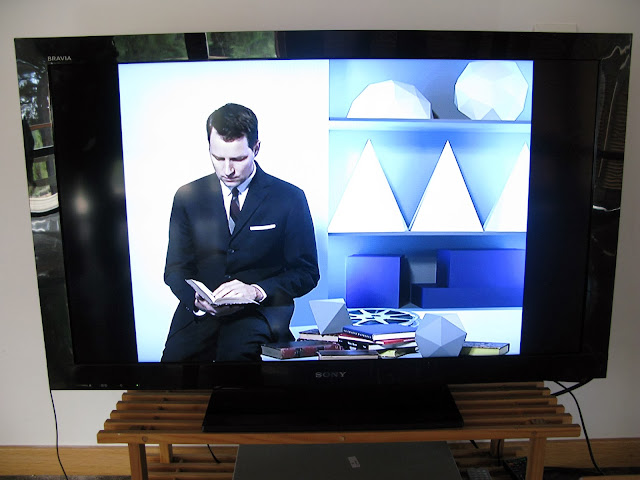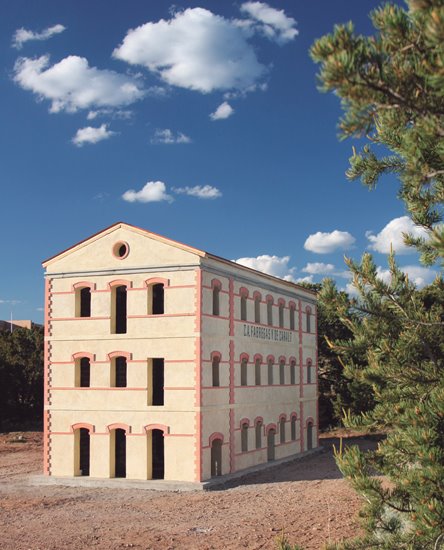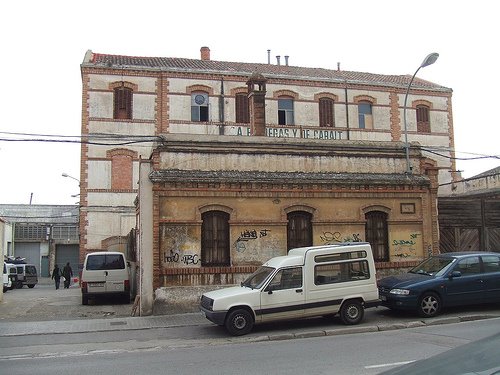"Modernitat Amagada" (Hidden Modernity), an exhibition at Casa Capell, Mataró (3–31 October 2013)
Fri, Nov 1 2013
Casa Capell at the Parc Central, Mataró.
'Modernitat Amagada' (3–31 October 2013), organised by ACM (Associació per a la Cultura i l’Art Contemporani de Mataró), was a short-lived group show at Casa Capell in Mataró, the wonderful former home of the Masjuan family ("former" as today there are hardly any traces of its original domestic use as it has been coverted into City Hall offices for its department of sustainability). It was built in 1959 by Jordi Capell (1925–1970), a little-known rationalist architect, mathematician and humanist.
The exhibition extended over two floors, presenting works by Alexander Apóstol, Xavier Arenós, Rafel G. Bianchi, Eva Fàbregas, Carla Filipe, Regina Giménez, Terence Gower and Jaume Roure, as well as works by its two organisers, the artists Domènec and Dani Montlleó. The works were mostly produced in 2013, and ranged from sculptural interventions (Eva
Fàbregas), responses to the home environment and its particular architecture (Rafel G. Bianchi, Regina Giménez, Jaume Roure), to contributions by artists whose artistic practice usually navigates the field of modern architecture (Terence Gower, Domènec, Xavier Arenós).
First room included works by Carla Filipe (on the table), Jaume Roure (by the chimney) and Eva Fàbregas (by the window). All works from 2013.
Carla Filipe, "Ideal City and Current Town" (2013). 10 acrylic stands with collages.
Detail of Carla Filipe's "Ideal City and Current Town" (2013).
Extending the line of her previous projects, Carla Filipe recuperated lost or forgotten memories, trying to connect unknown fragments of local history. Her modules revived the 'Moderno Escondido' (Hidden Modernity) concept which was developed by Portuguese architects in the 1950s and 60s and which resulted in a series of offices, chuches, domestic spaces and commercial spaces though now these are mostly abandoned, both physically and ideologically.
Regina Giménez, "Composició en vermell, groc, blau i blanc" (Composition in red, yellow, blue and white, 2013).
Regina Giménez thought of her painting as a wink to Capell, the house's modernist architect who was also a fervent activist for Catalan culture, dovetailing him with two referents of Modernism, the artist Piet Mondrian and the architect Mies van der Rohe. Her work suggested a possible intervention within the dinning room of Casa Capell – the incorporatation of a red carpet, white and blue cushions and a yellow wall – based on the principles of Neoplasticism, a movement which often used these primary colours in modern architecture, colours which are coincidentally also that of the Estelada, the Catalan independence flag.
Jaume Roure, "RE: Projecte Casa Capell" (2013).
Upon visiting the house and realising that little trace was visible of its original domestic use, Jaume Roure decided to recuperate the family presence by trying to locate photographs and personal memories of the original inhabitants. He couldn't find any photographs and only knew they were a couple with four children. He therefore tried to put faces to them by reconstructing a series of fictional images of what he thought they would look like, and framed them as if these memories were finally coming back to their original setting.
Eva Fàbregas, "Collapsible Sculptures" (2013).
The series "Collapsible Sculptures" reflected on the progressive 'containerisation' of our culture which since the 1950s has triggered a revolution in the production and transportation of merchandising. Our daily lives have also been highly affected by this shift: our food is able to be stored and transported and so are our domestic environments with modular, foldable, extensible or stackable items. Fàbregas sculptures (located in three spaces throughout the house), revealed the correspondences between mass-production and the aesthetics of Modernity.
Above: Jaume Roure, "RE: Projecte Casa Capell" (2013), and below on the screen the 17' video "New Utopias" (2010) by Terence Gower.
Still from "New Utopias" (2010) by Terence Gower.
(From the artist's website): "New Utopias is a lecture about pop culture utopias filmed in the style of a 1950s Walt Disney documentary. The set, costuming, lighting and camera work are based on 1950s television production standards. But where the original Disney documentaries celebrated rockets and nuclear technology, this updated version promotes aesthetic frivolity, sexual perversion and UFO abduction fantasies. Among the new utopias under analysis are an afrofuturist extraterrestrial society, a dreary French seaside town transformed into an aesthetic paradise, and a retelling of the Frankenstein myth set in a sexual utopia ruled by the uninhibited libido. This video is shown accompanied by the Mothership Blueprints."
Eva Fàbregas, "Collapsible Sculptures" (2013).
Rafel G. Bianchi, Album (2013). 6x7 slides on lightbox.
Rafel Bianchi's slides portrayed the cacti he had been documenting in his own garden in Barcelona. Upon visiting Casa Capell, he felt the need to bring some of the domesticity back to a space which was heavily restored in 2009–10 for it new adminstrative use. Cacti are a recurring motif used in the photographic documentation of architectural spaces, plants that often appear in photographs of works by the Catalan architect and city planner Josep Lluís Sert. Upon finishing a commission, Sert would arrange furniture and plants, with the aim of trying to give an appearance of domesticity and commodity as well as of Mediterraneity and modenity.
More "Collapsible Sculptures" by Eva Fàbregas downstairs by the window towering as cacti. These are reminiscent of those projected by Mexican architect Juan O’Gorman to protect Kahlo and Rivera's studio in Mexico City.
Lower gallery with works by Domènec (left) and Dani Montlleó (right).
Lower gallery with works by Dani Montlleó (left) and Alexander Apóstol (right).
Alexander Apóstol's photographic series "Le Corbusier quemado en Bogotá" (2005), documented the interior of the burnt Centro Nariño, a residencial campus of 23 buildings built in Bogotá, developed by Colombian architects following the doctrines of Le Corbusier, who earlier proposed a modern city that was finally never built. Amindst student revolts in the 60s, the buildings were set on fire, destroying most of its interiors, which are still intact amongst the ashes and electric wiring revealing some of the important traces that the Modern thinking left in Latin American cities.
Domènec, "Conversation Piece: Narkomfin" (2013). Maquette and formica chairs.
"Conversation Piece: Narkomfin" (2013) was supported on two formica chairs, typically used in 1950s and 60s homes, and a maquette of the social housing Narkomfin, a building that fascinated Le Corbusier in his 1930s trip to the Soviet Union and that later inspired his Unité Habitation in Marseille.
Maquette of Jean Prouvé's ’Maison Bulldog’ (2011) by Dani Montlleó.
This little half-bunker, half-trench-looking house of Dani Montlleó's work was also planned in 1959 (as was Can Masjuan house) for the writer Louis-Ferdinand Céline, although he died shortly after in 1961. The house was a replica of the Villa Arpel, designed by Jacques Lagrange for Jacques Tati's film "Mon Oncle" (1958).
Xavier Arenós, ’Madriguera#10. Proun. Desenterrament’ (2012). 15' with music by Rafa Ruiz.
Arenós' video, suitably projected in the lower floor storage room, recreated an excavation in which a Proun – a projection of an imaginary space, a term coined by El Lissitsky in the 1920s – is seemingly unearthed, like an anachronic residue of a remote civilisation, a transitional object. The accompanying futuristic soundtrack enhanced its science-fiction atmosphere.
–
This is the blog of the independent curatorial office Latitudes. You can also follow us on Facebook and Twitter.
All photos: Latitudes | www.lttds.org (except when noted otherwise in the photo caption)
This work is licensed under a Creative Commons Attribution-NonCommercial-NoDerivs 3.0 Unported License.
'Mataró Chauffeur Service' – graphic identity of the project
Mon, May 3 2010 Latitudes is soon participating in the London edition of 'No Soul for Sale – A Festival of Independents' which will take place in the Turbine Hall in Tate Modern, from 14–16 May, coinciding with the museum's 10th Anniversary celebrations.
Latitudes is soon participating in the London edition of 'No Soul for Sale – A Festival of Independents' which will take place in the Turbine Hall in Tate Modern, from 14–16 May, coinciding with the museum's 10th Anniversary celebrations.In response to the need to travel to London, Mataró-based artist Martí Anson (1967) has proposed to set up the company “Mataró Chauffeur Service”, and drive Latitudes from Barcelona [41º 23’N, 2º 11’E] to London [51°30′N 0°7′W] and back. Legally registering his employment as a driver, designing the livery of the single vehicle fleet and his uniform, and the journey to Tate Modern and back (including the ferry journey Santander–Portsmouth) all form a part of the project.
Here we present the graphic identity of Anson's chauffeur service, designed by the artist in collaboration with Barcelona-based graphic designer and publisher ferranElOtro.
 We are very pleased to announce that the car has been kindly provided by BMW.
We are very pleased to announce that the car has been kindly provided by BMW.And here is our chauffeur...
 And last, but certainly not least, we would like to thank the generous support of the Institut Ramon Llull, the SEACEX (Sociedad Estatal para la Acción Cultural Exterior), the Institut Municipal d'Acció Cultural of the Ajuntament de Mataró, Galeria Toni Tàpies, Barcelona, as well as thanking the in-kind-sponsorship provided by Loreak Mendian.
And last, but certainly not least, we would like to thank the generous support of the Institut Ramon Llull, the SEACEX (Sociedad Estatal para la Acción Cultural Exterior), the Institut Municipal d'Acció Cultural of the Ajuntament de Mataró, Galeria Toni Tàpies, Barcelona, as well as thanking the in-kind-sponsorship provided by Loreak Mendian. Exhibition 'Martí i la fàbrica de farina' (Martí and the flour factory), 24 April–31 May 2009, Can Palauet, Mataró (Barcelona)
Thu, Apr 23 2009'Martí i la fàbrica de farina' opens tomorrow 24 April at Can Palauet, Mataró [See installation photos at the end of this blog]. This solo exhibition by Martí Anson (Mataró, 1967) will present work related to his long-term project around the 'afectado' (meaning 'zoned') site of the flour factory Can Fàbregas i de Caralt in Mataró (recent image below), near Barcelona (campain to save the 1879 building here (in Catalan)).
Last year, Anson participated in Lucky #7, the SITE Santa Fe 7th International Biennial in New Mexico where he built a 1:25 scale copy of the factory (see first image). As is often characteristic of Anson's work, the important factor lies in the construction process, rather than in obtaining a pre-ordained final product. The mini building has in fact only two fully-rendered façades, as if a film set. He documented each day of the construction by setting up a video camera as well as through photo documentation, which was recently presented in ARCO'09 replicating the shape of the building (see image below).
Below an abstract of a text by curator Ferran Barenblit on Anson's work:
Martí Anson's work typically involves generating expectations in the viewer that are subsequently not fulfilled. (...) Time becomes an integral part of this process. For Anson, things do not change, but rather are constantly recomposed. Many of his works illustrate precisely this: a dislocation of time, of how events transpire – sometimes, to the point of ridicule. On other occasions, Anson demonstrates how, after patiently waiting and using that period of expectation for analysis, nothing happens. (...) A meticulous observer of reality, for him, the process is more important than the result, championing above all the value of work in art.
Installation photos of 'Martí i la fàbrica de farina' at Can Palauet and of the site where the flour factory stands (photos taken on the 24 April 2009):
'Martí and the flour factory' was commissioned by the SITE Santa Fe 7th International Biennial 'Lucky Number 7', more info here.
UPDATE: Below an article written by Oriol Fontdevila published in Culturas suplement of La Vanguardia from 23 May 2009 (in Catalan):
'Martí i la fàbrica de farina'
24 April–31 May 2009
Sales d'exposicions Can Palauet
c/ d'en Palau, 32 – Mataró (Barcelona)
Opening hours: Tue-Fri 6–9pm; Sat-Sun 11am–2pm and 6–9pm. Mondays closed.
[Images from top to bottom: Martí Anson, Installation view of 'Martí and the flour factory', 2008. Photo: BayAreaEventPhotography.com; Image of the Can Fàbregas i de Caralt factory in Mataró from the flickr album' Salvem Can Fàbregas' photostream, http://www.flickr.com/photos/salvem_can_fabregas; Photo installation at Galeria Toni Tàpies stand, ARCO 09, Photo: Latitudes]






















